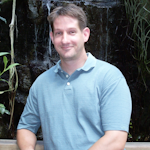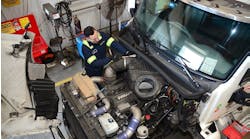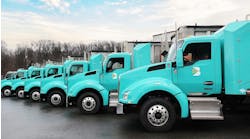Effective cleaning can restore a DPF to 90% capacity, according to Penske Truck Leasing’s Chris Hough. But sometimes reinstalling that restored DPF can do more harm than good.
“Attempting to extend the life of a cracked DPF threatens the truck and the environment,” said Lee Lackey, product manager with Noregon Systems. “After cleaning a DPF, a technician should perform a flashlight test to ensure cleaning was successful or determine if it’s best to just replace the filter. Each OE has different recommendations for cleaning or replacing, so follow their recommended practices.”
Cleaning in-house or by a third party might also be more trouble than simply ordering a remanufactured (reconditioned) filter, which Detroit Products advises to do. “Detroit has an extensive, proprietary, environmentally friendly washing service,” said Len Copeland, Detroit product marketing manager. “This process utilizes a liquid cleaning followed by the traditional high-temperature ‘bake and blow,’ removing more than 95% of the ash from the filter compared to about 30% on average for just ‘bake and blow’ cleaning.”
Cummins’ website advised that while a field cleaning is a cost-effective maintenance option for a DPF’s first recommended service, after that the filter should be swapped with a genuine OE replacement.
Aftermarket DPF providers selling in California, it should be noted, must gain approval by the California Air Resources Board to ensure they meet state requirements.
“Our preference is to always stick with the OEMs,” Hough said. “Then we know that the DPF is what the vehicle has been certified with. I’m not saying there is anything wrong with aftermarket. We’ve just never evaluated aftermarket filters or went in that direction.”
NACFE’s technical adviser, Kevin Otto, concurred. “When it comes to a product as technically sophisticated as a DPF, I would not be too quick to jump to an aftermarket product,” he noted. “From what I have seen, will-fit products copy designs but often thrift on certain things.”
“Not all aftermarket manufacturers are created equal,” Jerman said. “Fleets should do their homework and talk to other fleets. Don’t just take it from the manufacturer. Ask people who already use the product, and then let the product speak for itself.”
Roadwarrior began manufacturing DPFs for on-road vehicles in 2011, but its roots in diesel aftertreatment systems go back further. “We’re part of the DCL Technology Group, which has been making DPFs and catalysts for over 35 years, primarily servicing the stationery and construction/mining markets,” Jerman explained.
Jerman said Roadwarrior has worked to keep pace with product evolution. For example, when the industry started to shift from a cordierite substrate material to advanced cordierite, Roadwarrior followed suit. “The key is making sure your aftermarket product is a true OE replacement,” Jerman said. That means an aftermarket DPF’s characteristics and performance must match the OE version to work correctly with the engine ECM.
Jerman said supply chain challenges have driven new customers to Roadwarrior over the past year. “Many of the major U.S. dealers carry our products, including Rush Enterprises. We’ve been getting orders from places we normally would not expect, including some OE dealers. We had supply when a lot of others didn’t.”
According to Copeland, Detroit did not fall into that category of DPF have-nots.
“Detroit’s robust production, remanufacturing, and distribution centers are in the United States with American-made and sourced technologies. We are happy to report that there is no shortage of DPFs in our pipeline,” Copeland said.





